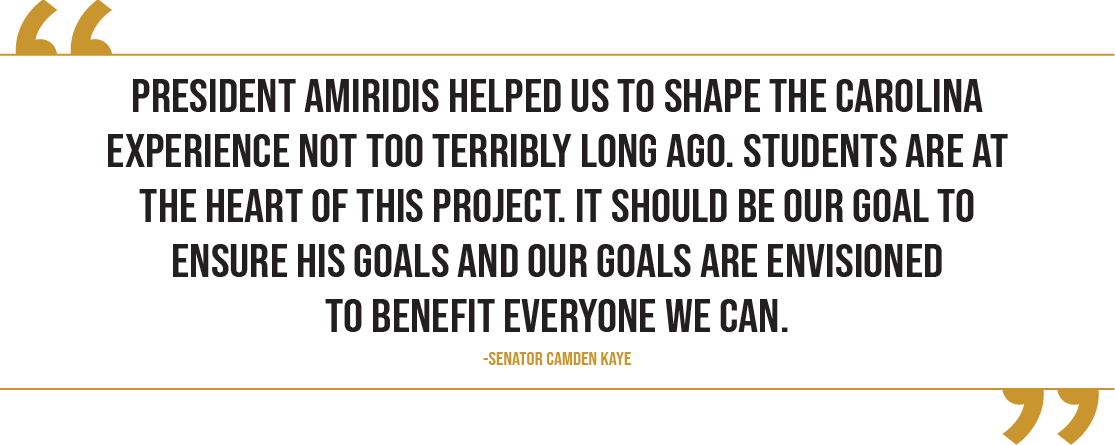USC's student senate presented on financial reform — including a proposal for an increase in activity fees and a proposal for potential student union construction plans — at its weekly meeting on Wednesday.
The ad hoc senate finance committee has worked on the presentation for the past three months to enhance the overall student experience. Through discussing student senate's internal finance issues, the enhanced student experience and the construction of a new student union, senators Camden Kaye, Jacob Vaught and speaker of the student senate Cameron Eubanks proposed solutions to improve campus life.
Kaye said that the Imagine Carolina retreat, which was created in 2022 to allow students to share their views and ideas with university leaders, is essential to improving student experience. He said that students play a central role in this event.
"President Amiridis helped us to shape the Carolina experience not too terribly long ago," Kaye said. "Students are at the heart of this project. It should be our goal — it should be our why — to ensure that his goals are envisioned and that our goals are envisioned to benefit everyone we can."

He said there are three primary concerns in the Student Government's financial reform, including an outgrowth of the current student activity fund, financial code language confusion and the way that event funding is prioritized.
The campus activity fee is currently $87 per semester for full-time students. This fee funds on-campus activities, such as Tiger Burn and Russell House events. Vaught said that with an increase in inflation and student organization growth, this fee should also increase.
Student Government gets 3% of the student activity fee, which comes to $186,000, and is able allocate this amount of money to student organizations for the academic year.
Vaught said that without an additional increase in funding, the finance committee had to make cuts in certain places.
"One of the things we've done is we've had one of the strictest finance committees in about the last decade," Vaught said. "We approved about 60% of any allocations that went through, so a lot lower than in previous years — it was closer to 70% to 80%. So we've done a lot to combat this, but it's still not enough, and it won't be enough if the trends keep continuing with inflation and org growth."
According to the presentation, with inflation and organization growth combined, average spending would be $350,000 if Student Government continues its 60% allocation rate for the next two years. The increased activity fee would mean an 88% increase for the overall Undergraduate Student Organization Fund.
"We are proposing a kind of a double solution. We want to first increase the campus activity by $13. We think it's a very small increase with students, and this will be able to improve the critical support for tons of students on campus," Vaught said. "This will allow for more events to be funded — Tiger Burn, anything Gamecock Entertainment does, a lot of Greene Street events, a lot of things that happen in Russell."
The last time the student activity fee increased was in 2016, when the fund increased by $2.
Vaught said that Student Government would like to see its pot of the budget increased from 3% to about 5% to meet its proposed budget expectation of $350,000. Having an increased budget would allow the finance committee to allocate more funds to a wider variety of student organizations, he said.
Also at the meeting, Eubanks discussed potential plans for the construction of a new student union. The building will cost around $260 million to construct.
Russell House had its last renovation in 1976, when the university had an enrollment of 23,854 students. The current enrollment is 35,590 students. USC ranks last in the SEC for having recent student union renovations.
USC's 2023 freshman class set a record as the university's largest-ever undergraduate class, boasting a total of 7,344 students with more expected to enroll in the next few years.
"I absolutely think (the new student union) will be beneficial for students in the long run," Student Body President Emmie Thompson said. "If we're going to continue to grow, we have to build the infrastructure to be able to sustain that growth."
The proposed timeline for the new student union exists in three phases. The pre-demolition phase would take place from 2024 to 2025, where various academic spaces and local venues will start being utilized by student organizations. The next phase is the construction of a new dining facility, which would take place from 2025 to 2028. The last phase is the construction of a new union, which would last from 2028 to the 2030s.
"I think our new student union is going to allow more opportunities and more experiences to be had in the student experience here on campus and in student life in general. And it'll allow certain departments to grow and offer more programs and expansion of their services," Eubanks said.
Eubanks said that USC's dining facilities on the first and second levels are at maximum capacity. A new student union would ensure that students have access to a variety of food options and would include a 50% increase in student organization space, eliminating reservation conflicts and providing more meeting space. The aim is to double the available space for student organizations, he said.
The student senate also passed one piece of legislation during its meeting.
The legislation that passed, SBL11550, is a recommendation to honor the life of Carlton Thompson, also known as "Gamecock Jesus," at Colonial Life Arena. Thompson passed away to cancer in December. The legislation passed by acclamation.
Editor's note: This article has been corrected to clarify that the Russell House project are just proposed plans. Nothing is set has been approved by the board of trustees.

